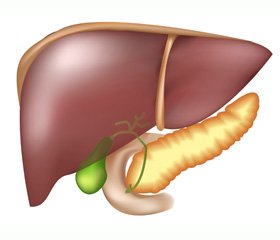Журнал «Здоровье ребенка» 4 (55) 2014
Вернуться к номеру
Metabolic syndrome as a basis of nonalcoholic fatty liver disease in obese children
Авторы: T.O. Kryuchko, O.A. Pylypenko, I.M. Nesina - Higher State Educational Establishment of Ukraine “Ukrainian Medical Stomatological Academy”, Poltava
Рубрики: Педиатрия/Неонатология
Разделы: Клинические исследования
Версия для печати
syndrome, nonalcoholic fatty liver disease, children
To date, metabolic syndrome (MS) is one of the world’s most pressing health and social problems. Among the population of economically developed countries, according to different authors, the prevalence of MS ranges from 25 to 40 %. However, at present the manifestations of metabolic syndrome prevail in pediatric and adolescent population, with a strong tendency to increase. Currently, the diagnosis of metabolic syndrome in children and adolescents is based on the Agreed criteria suggested by the International Diabetes Federation (IDF) in 2007. The literature presents numerous data on the pathogenic mechanisms of liver damage by MS; it is known that the development of nonalcoholic fatty liver disease (NAFLD) in 90% of cases is associated with type 2 diabetes, abdominal obesity, and atherogenic dyslipidemia.
The aim of our study was to determine the relationship between the presence and prevalence of major components of metabolic syndrome and the development of NAFLD in patients of infancy and adolescence.
Materials and methods. In total 39 children aged from 7 to 17 were under the observation. All patients were divided into two groups. The main group (n = 23) included children in whom NAFLD was diagnosed against the background of pronounced obesity, the comparison group (n = 16) included patients with diagnosed obesity without liver disorders, the control group consisted of healthy children (n = 10) identical in terms of sex and age. All children underwent a comprehensive survey which included collecting the anamnestic data, anthropometry and general clinical tests. For detection of carbohydrate metabolism disorders all patients underwent fasting glucose test (FGT), oral glucose tolerance test (OGTT), measurement of immunoreactive insulin concentration and calculation of insulin resistance index НОМА – IR. The indicators of blood lipids were also determined: total cholesterol (TC), triglycerides (TG), high-density lipoprotein cholesterol (HDL-C), low-density lipoprotein cholesterol (LDL-C) and very low-density lipoprotein cholesterol (VLDL-C); the atherogenic index (AI) was also calculated.
Results and discussion. According to our study, the increased body mass index (BMI) in relation to percentile tables by age and sex was observed in patients of both groups, but the rates were significantly higher among children with diagnosed NAFLD (30,7 ± 0,61 and 28,1 ± 0,64 respectively, p < 0,05). Indicators of waist to hips measurement (WM/HM) – the markers of abdominal obesity – were significantly higher in the group of children with NAFLD (0,96 ± 0,01 and 0,83 ± 0,01 respectively, p <0, 01). According to our data, the increased blood pressure was observed in 43.5 % of children with NAFLD which significantly differed from the prevalence of this index in the group of children with exogenous-constitutional obesity (16%, p < 0,05). Fasting glucose was within normal limits in almost all surveyed children (90.5 %), but the average indices were significantly higher in children with diagnosed fatty liver disease (4,7 ± 0,15 and 4,2 ± 0,09 respectively, p < 0,05). Basal hyperinsulinemia was detected in 26 % of patients with diagnosed NAFLD – significantly more often than in obese children without liver dysfunction (6.25 %, p < 0,05). HOMA – IR index was significantly higher in the group of children with NAFLD (p < 0,01). The examination of lipid profile demonstrated that the group of children with NAFLD, unlike patients with alimentary obesity revealed the highest concentration of TG in blood serum (1,62 ± 0,14 vs. 0,83 ± 0,02 mmol / l respectively, p < 0.01) and lower level of HDL-C (1,06 ± 0,06 vs. 1,16 ± 0,06 mmol / l).
Conclusions. The obtained results demonstrated that insulin resistance was the most widespread component among the examined children and adolescents with NAFLD against the background of obesity; it was observed in 56.5 % of children, 43.5 % of patients had signs of arterial hypertension (AH), dyslipidemia by lowering HDL-C fraction was observed in 43.5 % of cases, hypertriglyceridemia – in 34.7 % of cases. The total form of five components of metabolic syndrome was found in almost one of four patients (24.5 %) with NAFLD; the presence of four criteria was detected in 31 % of patients; all other children (44.5 %) had different combinations of two or three components. These results offer the possibility to diagnose high prevalence of metabolic syndrome in children and adolescents with NAFLD. Active detection and prevention of the initial MS symptoms can help to reduce the risk of associated diseases, including nonalcoholic fatty liver disease.

